LANSITEC Information Technology 100-00159 LoRa Platinum Temperature Sensor User Manual
Nanjing Lansitec Information Technology Co., LTD LoRa Platinum Temperature Sensor Users Manual
User manual

LoRa Platinum Temperature Sensor
0/12
Document Number: 990-02101
Rev. 1.22 12/2017
contact@lansitec.com
General Description
Lansitec precision platinum temperature sensor is based on
the advanced LoRa modulation and powered by lithium
battery with 6-year operation time. It is cost effective
LoRaWAN end device for a variety of application. It's long
operation time offers low maintenance and is ideal for
industry use. Sensor work mode can be adjusted via LoRa
network.
Lansitec sensors family is fully compatible and plug & play
for LoRaWAN network operation.
Lansitec sensors can also work with Lansitec Wireless Data
Transfer Unit (P/N: 100-00175) for low cost deployment.
Please contact us for further information.
Applications
Busway temperature monitor
Weather station
Heating
Ventilation & air conditioning systems
Smart Agriculture
Building automation
Key features
Powered by lithium thionyl chloride battery: 5 years of
operation for 1 uplink 5 minutes.
Extended industrial operating temperature:
-40°C to +85°C.
Accuracy:
±1.5°C typically from -200°C to +200°C.
LoRaWAN compatible:
Class A, uplink rate programmable from 30 seconds to
24 hours.
Change uplink cycle via wireless, configurable by server via
downlink command
Operating frequency bands (Option at order):
900MHz, < 25mW radiated power
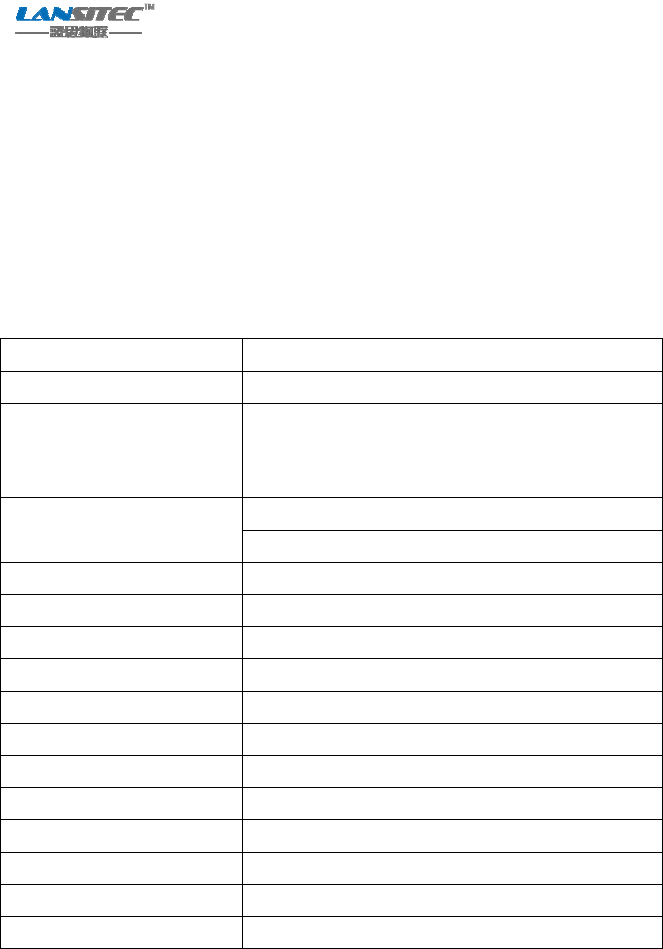
LoRa Platinum Temperature Sensor
1/12
1. Product specifications
The tables below give the electrical specifications and performance of the temperature and humidity
measurement.
Table 1 General electrical characteristic
Protocol LoRaWan1.0.2
Frequency CN470, EU868, US915, AS923, CLAA
Sensitivity
SF=7 ≤ -126dBm
SF=10 ≤ -136dBm
SF=12 ≤ -142dBm
Operating Current 30uA@sleep mode
Max 138mA@17dBm
Temperature Range -200~200℃
Accuracy ±1.5℃
Standby Time 6 years @25℃ 17dBm 5 minutes per transmission
Operating Temperature -40~+85℃
Storage Temperature -55~+85℃
Operating Humidity 5%~95%
On/Off Support
Sensor Quantity 4, external, cable length is optional
Antenna External
Dimension Aluminum, 76x46x110mm
Battery Non-chargeable lithium battery 38Ah
Communication Distance >1km in urban area
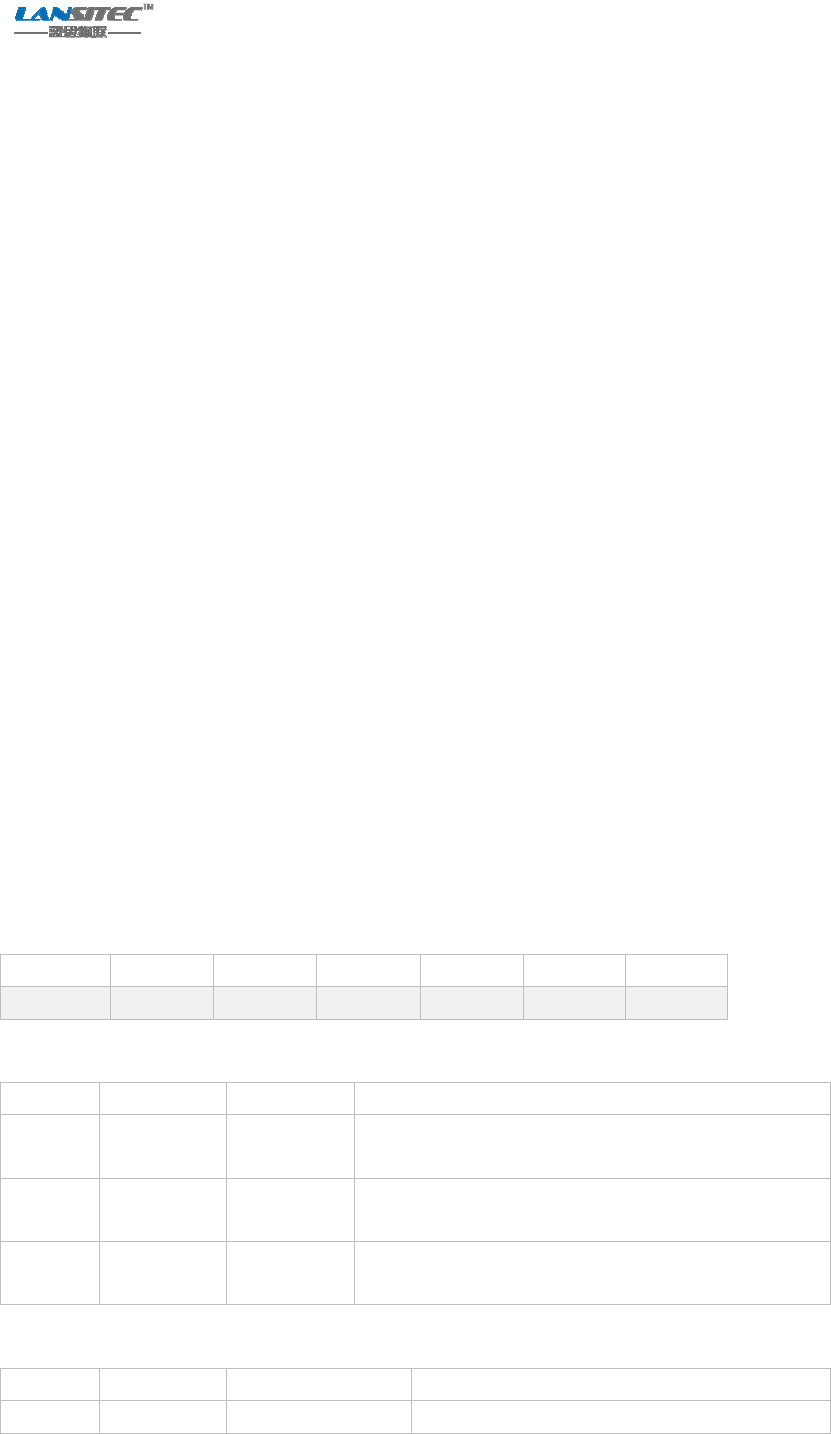
LoRa Platinum Temperature Sensor
2/12
2. Application Information
2.1 Function
The sensor works in OTAA and Class A mode. DEVEUI, APPEUI and APPKEY are stored in the sensor
and is necessary for joining a network. DEVEUI is labeled at the back of the device. APPEUI, APPKEY
should be provided by each application. Lansitec will help to configure this before shipping.
After power on and join the Lora network, sensor will send registration message to Application
Server(AS). If AS doesn’t reply, sensor will retry for 3 times before switching to default mode
(periodically report mode). Configuration information of the sensor is included in this registration
message for AS to validate.
Sensor starts to work after receiving acceptance response or no AS reply after 3 times registration
trial. Temperature will be reported to AS periodically. The duty cycle is configurable by commands
from AS. Temperature acquisition and report period is 5 minutes by default.
According to LoRaWAN specification, downlink response time is decided by uplink duty cycle, user
should refer the needed response time to choose uplink duty cycle. Detailed downlink and uplink
definition are described below.
2.2 Uplink Message
2.2.1 Register
Bytes 1 1 1 1 2 2
Item TYPE SMODE POWER CFG TH CRC
TYPE field
Bit Name Value Description
7~4 TYPE 0x1 Message type. AS can use it to identify different
uplink messages.
3ADR 0:OFF
1: ON
ADR (Adaptive Date Rate) status
2~0 MODE 0x01~0x07 Current working scheme which should be one of
SMODE
SMODE field
Bit Name Value Description
7~0 SMODE 0x01: AU920 Data scheme supported by tracker.
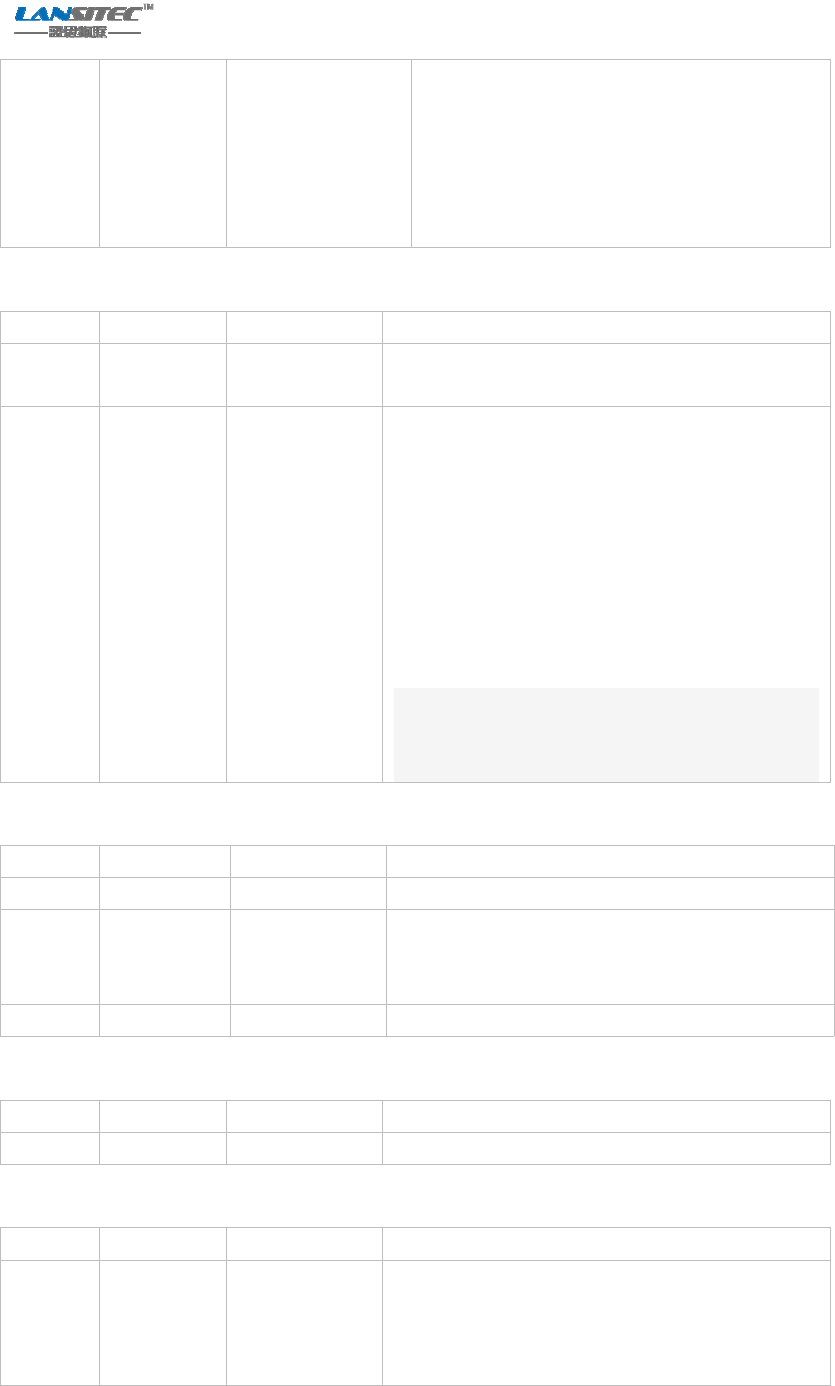
LoRa Platinum Temperature Sensor
3/12
0x02: CLAA
0x04: CN470
0x08: AS923
0x10: EU433
0x20: EU868
0x40: US915
This field is preserved by Lansitec and will be
configured before shipping.
POWER field
Bit Name Value Description
7~3 POWER 0~31 Configured transmit power (dBm))
2~0 Reserved 0x0 Reserved for future use. If MODE is CLAA, it
indicates the frequency sweep mode of the
tracker:
1: A mode
2: B mode
3: C mode
4: D mode
5: E mode
6: All frequency sweep
Refer to CLAA China 470M-510M Band Using
network technology requirements for detailed
information.
CFG field
Bit Name Value Description
7~4 DR 0~15 Data Rate(DR0~DR15).
3 REPTIND 0~1 Indicates whether report the temperature if the
value is the same with before. Default value is 0,
means always report.
2~0 Reserved 0x0 Reserved for future use.
TH field
Bit Name Value Description
15~0 TH 1~65535 The period of temperature report, unit 10s.
CRC field
Bit Name Value Description
15~0 CRC CRC16 of previous fields with TYPE bits set to 0,
the polynomial is . AS only need to compare this
data field with the AS stored one to judge
whether configuration changed.
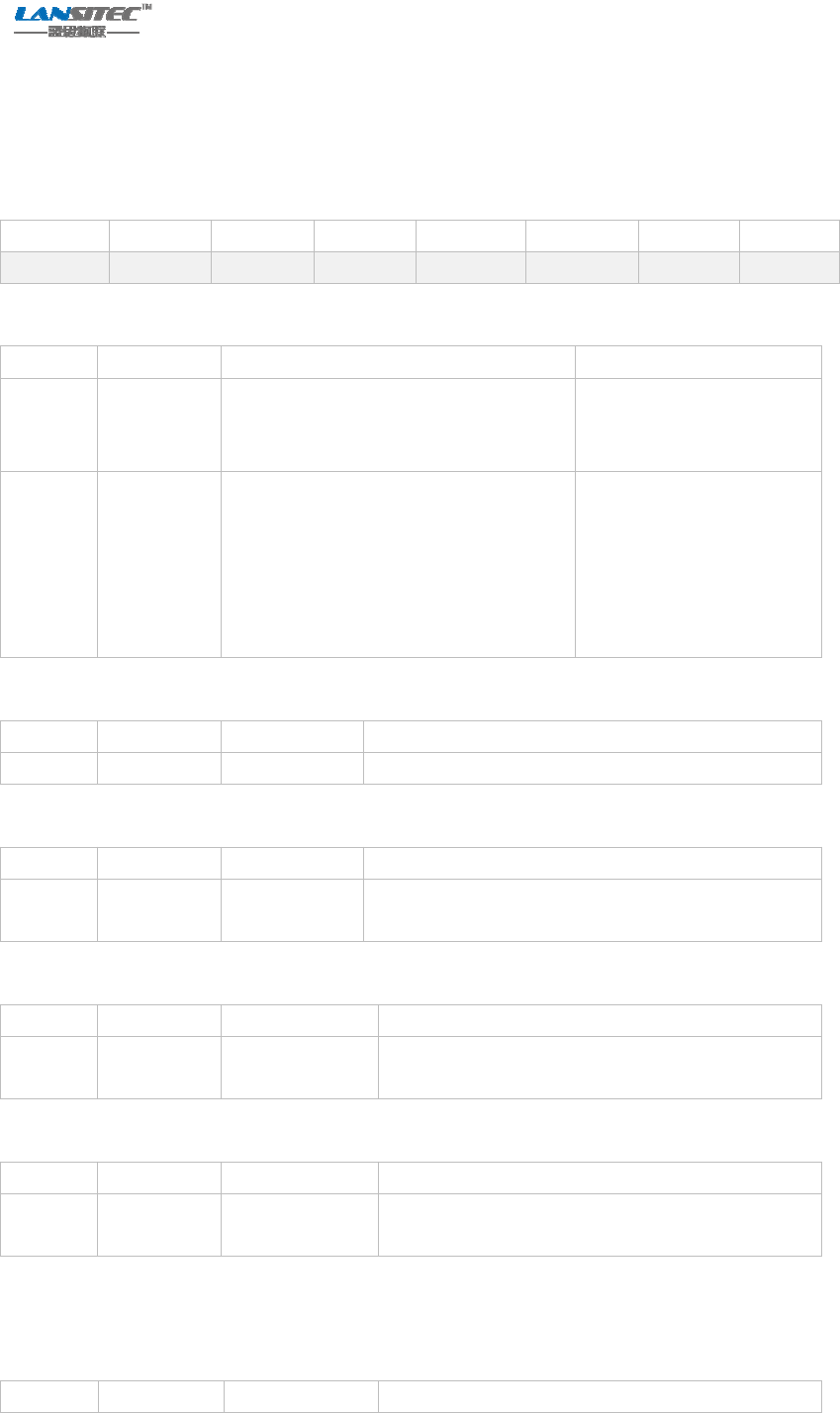
LoRa Platinum Temperature Sensor
4/12
2.2.2 Periodical temperature and humidity
Bytes 1 1 1 2 2 … 2
Item TYPE RFU RSSI TEMP1 TEMP2 …CRC
TYPE field
Bit Name Value Description
7~4 TYPE 0x3 Message type, AS can use
it to identify different
uplink messages.
3~0 TNUM 0x0~0x4 Number of sensor. For
example, if TNUM is 0x3,
there should be TEMP1,
TEMP2 and TEMP3, the
whole message length
should be 11 bytes.
RFU field
Bit Name Value Description
7~0 RFU 0 Reserved for future use.
RSSI field
Bit Name Value Description
7~0 RSSI 0~160 Received Signal Strength Indication
(unit: -1dBm)
TEMP1 field
Bit Name Value Description
short TEMP1 -20000~20000 (unit: 0.01℃)
TEMP2 field
Bit Name Value Description
short TEMP2 -20000~20000 (unit: 0.01℃)
TEMP number is decided by field TNUM.
CRC field
Bit Name Value Description
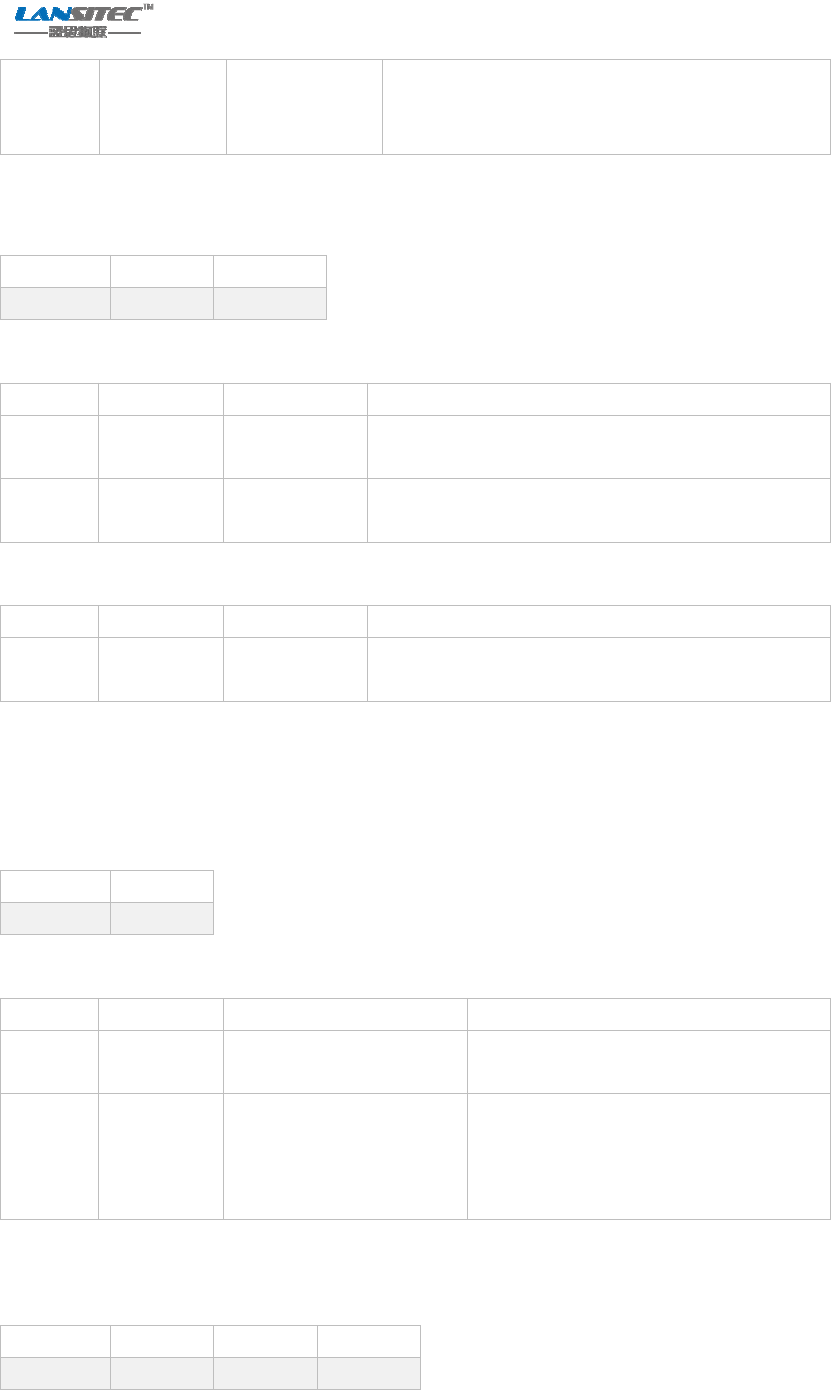
LoRa Platinum Temperature Sensor
5/12
15~0 CRC Same CRC16 as calculated in register message.
This can be used for server to check if any
configuration mismatch.
2.2.3 Acknowledge
Bytes 1 1
Item TYPE MSGID
TYPE field
Bit Name Value Description
7~4 TYPE 0xF Message type, AS can use it to identify different
uplink messages.
3~0 RESULT 0: success
1: failure
Process result of any downlink message that need
acknowledge
MSGID field
Bit Name Value Description
7~0 MSGID 0~255 The MSGID field of corresponding downlink
message
2.3 Downlink
2.3.1 Register acceptance
Bytes 1
Item TYPE
TYPE field
Bit Name Value Description
7~4 TYPE 0x1 Message type, tracker can use it to
identify different downlink messages.
3~0 RESULT 0: success
1: failure
Register result, currently the device
doesn’t distinguish the result, device
always take it as success if response
received.
2.3.2 Lora configuration
Bytes 1 1 1
Item TYPE DR MODE
TYPE field
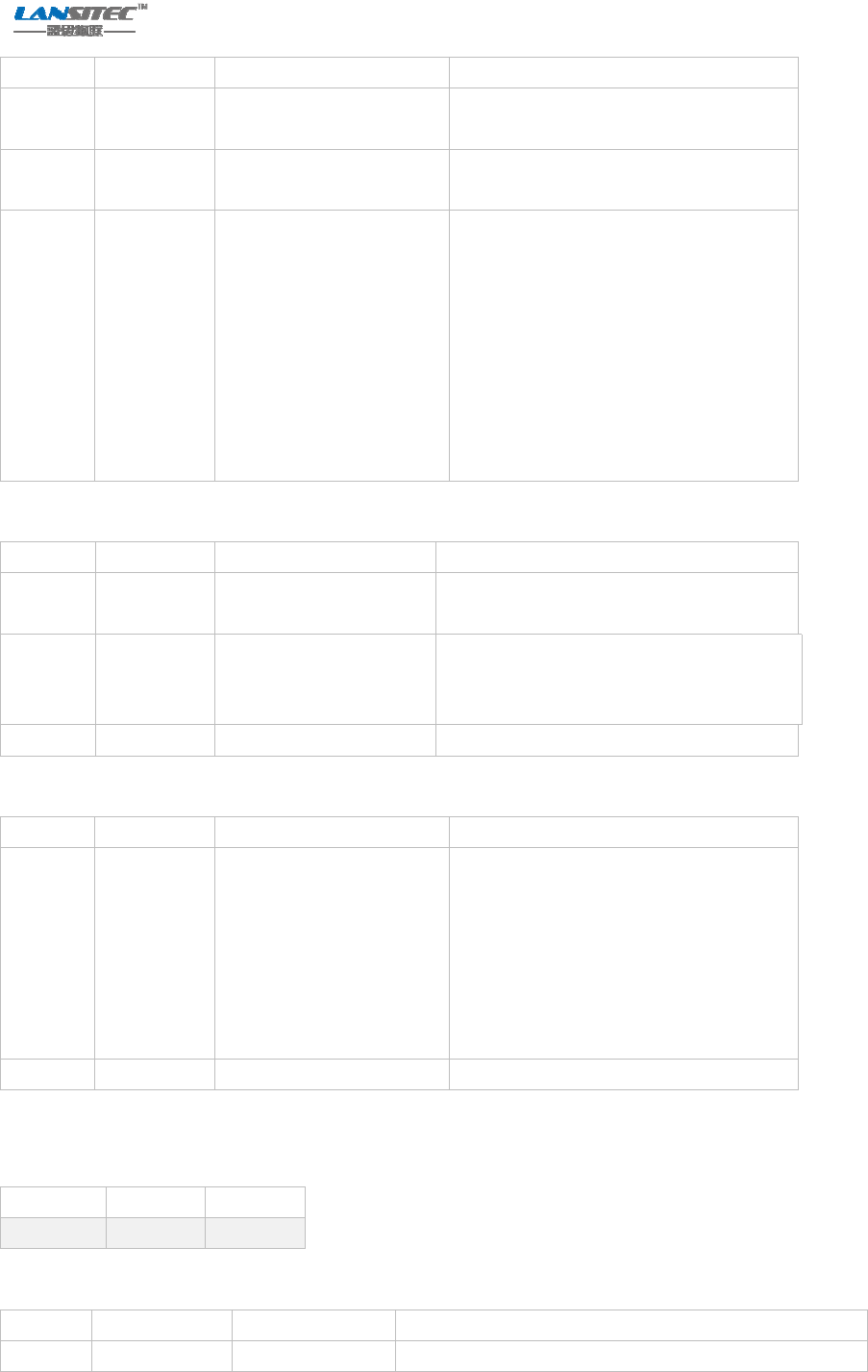
LoRa Platinum Temperature Sensor
6/12
Bit Name Value Description
7~4 TYPE 0x8 Message type, tracker can use it to
identify different downlink messages.
3ADR 0:OFF
1: ON
ADR (Adaptive Date Rate) status
2~0 Reserved 0x0 Reserved for future use. If MODE is
CLAA, it indicates the frequency sweep
mode of tracker:
1: A mode
2: B mode
3: C mode
4: D mode
5: E mode
6: all frequency sweep
DR field
Bit Name Value Description
7~4 DR 0~15 Data Rate(DR0~DR15), if ADR is disabled,
the device will work on this data rate.
3 REPTIND 0~1 Indicates whether report the temperature
ifthevalueisthesamewithbefore.
Default value is 0, means always report.
2~0 Reserved 0 Reserved for future use
MODE field
Bit Name Value Description
7~5 MODE 0x1:AU920
0x2:CLAA
0x3:CN470
0x4:AS923
0x5:EU434
0x6:EU868
0x7:US915
Configure mode. Currently the mode
can’t be changed. It should be always
thesamewiththevaluereportedby
the device.
4~0 POWER 0~31 Configure transmit power (unit dBm)
2.3.3 Sensor configuration
Bytes 1 2
Item TYPE TH
TYPE field
Bit Name Value Description
7~4 TYPE 0x9 Message type, tracker can use it to identify different
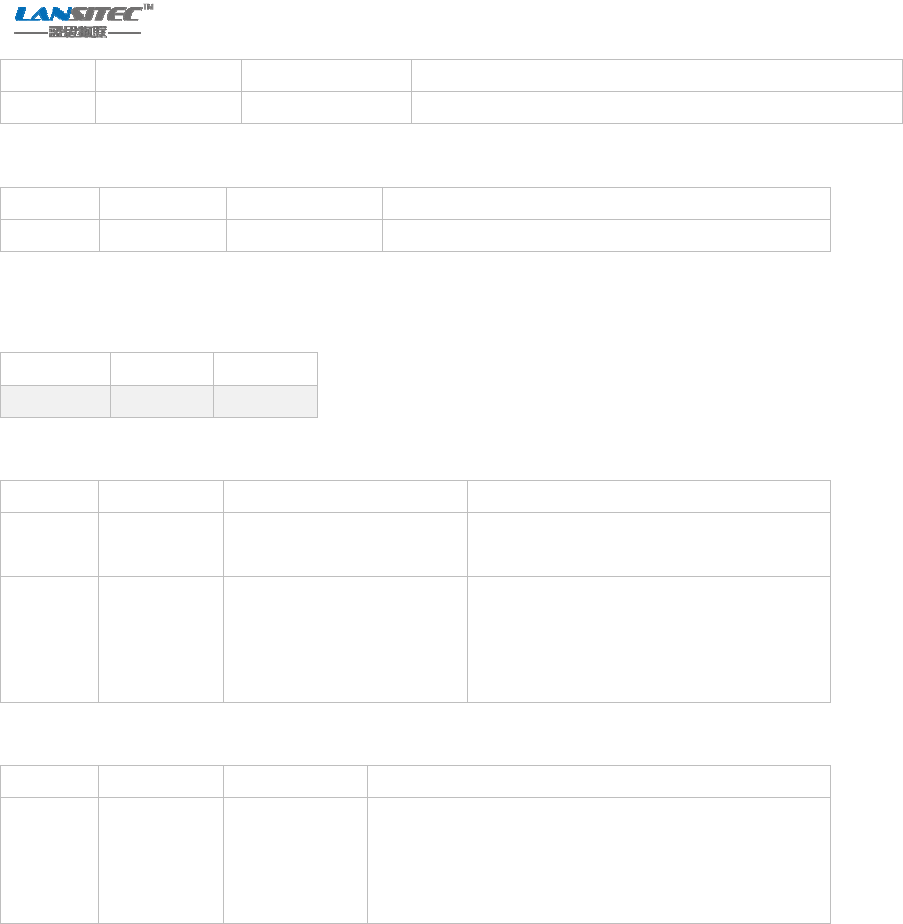
LoRa Platinum Temperature Sensor
7/12
downlink messages.
3~0 Reserved 0x0 Reserved for future use.
TH field
Bit Name Value Description
15~0 TH 1~65535 The period of temperature report, unit 10s.
2.3.4 Command request
Bytes 1 1
Item TYPE MSGID
TYPE field
Bit Name Value Description
7~4 TYPE 0xA Message type, tracker can use it to
identify different downlink messages.
3~0 COMMAND 0x1: register request
0x2: device reset
Requested command.
0x1usedtorequestthedevicetosend
register message.
0x2 used to reset the device.
MSGID field
Bit Name Value Description
7~0 MSGID 0~255 Server generated sequence number of downlink
messages that need MSGID. Tracker will respond
ACK with this number, otherwise AS should resend
the message.
3. Mechanical structure and Assembly
3.1 Dimension
3.2 Batteryinstallation
Battery holder is inside the sensor. Just insert the 3.6V battery to the holder, the sensor will
start work with a default cycle. Please follow steps below when install a new battery.
Step1: Remove the cover.
Step2: Install the battery.
Step3: Reset the device.

LoRa Platinum Temperature Sensor
8/12
Step4: Close and fix the cover again.
Note: Don’t inverse the polarity of the battery when insert the holder!!!
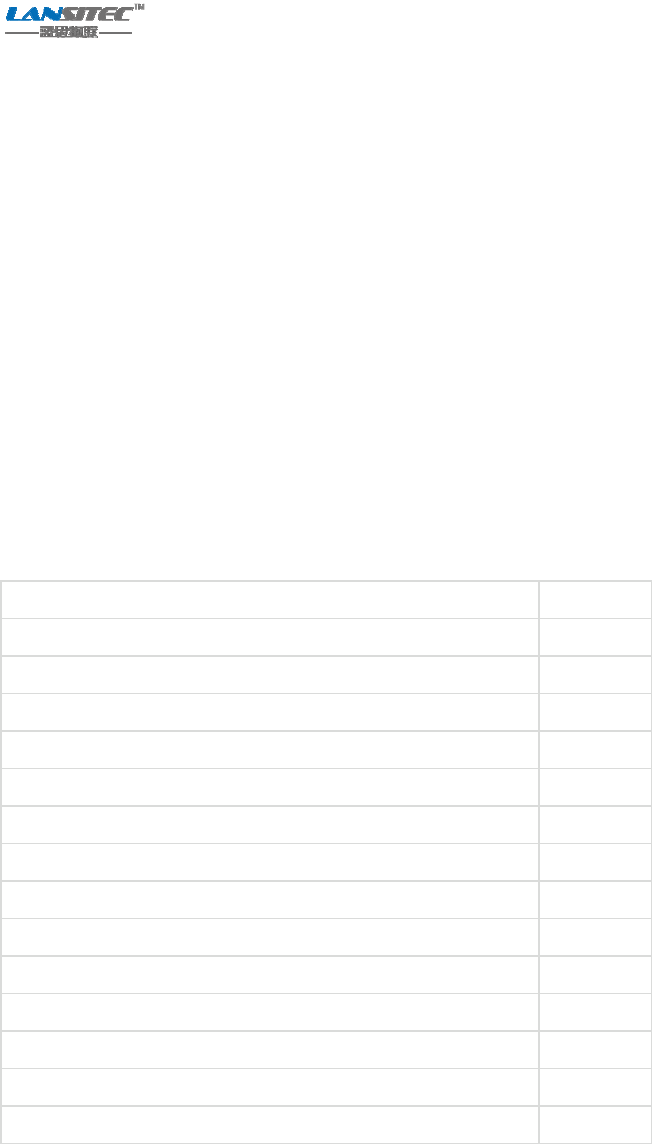
LoRa Platinum Temperature Sensor
9/12
3.3 Sensor Fixation
On the back of the housing, there are 4 screw mounting holes which are isolated from inside of
the device.
3.4 Battery information
Lithium/thionyl chloride battery with PN ER34615 is used in the sensor, which could operate in -55 to +85
℃.
4. Ordering Information
LoRa Platinum Temperature Sensor, US915, 1 sensor, 38Ah 100-00159
LoRa Platinum Temperature Sensor, US915 2 sensors, 38Ah 100-00158
LoRa Platinum Temperature Sensor, US915, 4 sensors, 38Ah 100-00182
LoRa Platinum Temperature Sensor, EU868, 1 sensor, 38Ah 100-00169
LoRa Platinum Temperature Sensor, EU868, 2 sensors, 38Ah 100-00168
LoRa Platinum Temperature Sensor, EU868, 4 sensors, 38Ah 100-00176
LoRa Platinum Temperature Sensor, CN470, 1 sensor, 38Ah 100-00178
LoRa Platinum Temperature Sensor, CN470, 2 sensors, 38Ah 100-00177
LoRa Platinum Temperature Sensor, CN470, 4 sensors, 38Ah 100-00179
LoRa Platinum Temperature Sensor, AS923, 1 sensor, 38Ah 100-00181
LoRa Platinum Temperature Sensor, AS923, 2 sensors, 38Ah 100-00180
LoRa Platinum Temperature Sensor, AS923, 4 sensors, 38Ah 100-00162
LoRa Platinum Temperature Sensor, CLAA, 1 sensor, 38Ah 100-01158
LoRa Platinum Temperature Sensor, CLAA, 2 sensors, 38Ah 100-01159
LoRa Platinum Temperature Sensor, CLAA, 4 sensors, 38Ah 100-01160

LoRa Platinum Temperature Sensor
10 /12
Please Read Carefully:
Information in this document is provided solely in connection with Lansitec products. Lansitec reserve the right to make changes,
corrections, modifications or improvements, to this document, and the products and services described herein at any time, without
notice.
All Lansitec products are sold pursuant to Lansitec’s terms and conditions of sale.
Purchasers are solely responsible for the choice, selection and use of the Lansitec products and services described herein, and
Lansitec assumes no liability whatsoever relating to the choice, selection or use of the Lansitec products and services described
herein.
No license, express or implied, by estoppel or otherwise, to any intellectual property rights is granted under this document. If any part
of this document refers to any third-party products or services it shall not be deemed a license grant by Lansitec for the use of such
third-party products or services, or any intellectual property contained therein or considered as a warranty covering the use in any
manner whatsoever of such third party products or services or any intellectual property contained therein.
UNLESS OTHERWISE SET FORTH IN LANSITEC’S TERMS AND CONDITIONS OF SALE Lansitec DISCLAIMS ANY
EXPRESS OR IMPLIEDWARRANTY WITH RESPECT TO THE USE AND/OR SALE OF Lansitec PRODUCTS INCLUDING
WITHOUT LIMITATION IMPLIEDWARRANTIES OF MERCHANTABILITY, FITNESS FOR A PARTICULAR PURPOSE (AND
THEIR EQUIVALENTS UNDER THE LAWSOF ANY JURISDICTION), OR INFRINGEMENT OF ANY PATENT, COPYRIGHT OR
OTHER INTELLECTUAL PROPERTY RIGHT.
LANSITEC PRODUCTS ARE NOT DESIGNED OR AUTHORIZED FOR USE IN: (A) SAFETY CRITICAL APPLICATIONS SUCH AS
LIFE SUPPORTING, ACTIVE IMPLANTED DEVICES OR SYSTEMS WITH PRODUCT FUNCTIONAL SAFETY REQUIREMENTS;
(B) AERONAUTIC APPLICATIONS; (C) AUTOMOTIVE APPLICATIONS OR ENVIRONMENTS, AND/OR (D) AEROSPACE
APPLICATIONS OR ENVIRONMENTS. WHERE LANSITEC PRODUCTS ARE NOT DESIGNED FOR SUCH USE, THE
PURCHASER SHALL USE PRODUCTS AT PURCHASER’S SOLE RISK, EVEN IF LANSITEC HAS BEEN INFORMED IN WRITING
OF SUCH USAGE, UNLESS A PRODUCT IS EXPRESSLY DESIGNATED BY LANSITEC AS BEING INTENDED FOR
“AUTOMOTIVE, AUTOMOTIVE SAFETY OR MEDICAL”INDUSTRY DOMAINS ACCORDING TO LANSITEC PRODUCT DESIGN
SPECIFICATIONS. PRODUCTS FORMALLY ESCC, QML OR JAN QUALIFIED ARE DEEMED SUITABLE FOR USE IN
AEROSPACE BY THE CORRESPONDING GOVERNMENTAL AGENCY.
Resale of Lansitec products with provisions different from the statements and/or technical features set forth in this document shall
immediately void any warranty granted by Lansitec for the Lansitec product or service described herein and shall not create or
extend in any manner whatsoever, any liability of Lansitec.
Lansitec and the Lansitec logo are trademarks or registered trademarks of Lansitec in various countries.
Information in this document supersedes and replaces all information previously supplied.
The Lansitec logo is a registered trademark of Lansitec. All other names are the property of their respective owners.
©2015 LANSITEC - All rights reserved
http
:
//
www.
l
ans
it
ec.com

LoRa Platinum Temperature Sensor
11 /12
Federal Communications Commission (FCC) Statement
This device complies with part 15 of the FCC Rules. Operation is subject to the following two conditions: (1)
This device may not cause harmful interference, and (2) this device must accept any interference received,
including interference that may cause undesired operation.
Note: This equipment has been tested and found to comply with the limits for a Class B digital device,
pursuant to part 15 of the FCC Rules. These limits are designed to provide reasonable protection against
harmful interference in a residential installation. This equipment generates, uses and can radiate radio
frequency energy and, if not installed and used in accordance with the instructions, may cause harmful
interference to radio communications. However, there is no guarantee that interference will not occur in a
particular installation. If this equipment does cause harmful interference to radio or television reception, which
can be determined by turning the equipment off and on, the user is encouraged to try to correct the
interference by one or more of the following measures:
●Reorient or relocate the receiving antenna.
●Increase the separation between the equipment and receiver.
●Connect the equipment into an outlet on a circuit different from that to which the receiver is connected.
●Consult the dealer or an experienced radio/TV technician for help.
Warning: Changes or modifications made to this device not expressly approved by Nanjing Lansitec
Information Technology Co., LTD may void the FCC authorization to operate this device.
Note: The manufacturer is not responsible for any radio or TV interference caused by unauthorized
modifications to this equipment. Such modifications could void the user’s authority to operate the equipment.
The distance between user and products should be no less than 20cm